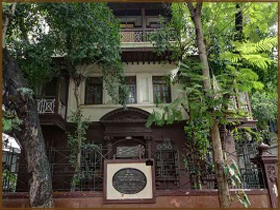Gandhi Heritage Sites - Writeups
You are here
Mani Bhavan, Mumbai

Connection with Gandhiji
Owned by Gandhiji's close associate Dr. Pranjivan Mehta’s elder brother Revashankar Jagjeevan Jhaveri, it was the house that hosted Gandhiji during his many visits to Mumbai. Mani Bhavan became the nerve center of Gandhiji’s activities and an epicenter of India’s struggle for freedom, especially from1917 to 1934, the period during which Gandhiji stayed there frequently.
Background
Dr. Pranjivan Mehta was one of the oldest associates and closest friend of Gandhiji. When Gandhiji went to England as a law student in 1888, he carried four notes of introduction. One of them was addressed to Pranjivan Mehta who while studying medicine in Brussels, had enrolled himself at London’s Middle Temple to qualify as a barrister. They formed a lifelong friendship. On his return to India on 5 July, 1891, Gandhiji stayed at Revashankar Jhaveri’s house for some time. When he returned to India from South Africa, he stayed at Revashankar’s place at Santacruz. When Revashankar shifted to Mani Bhavan, it became Gandhiji’s preferred place to stay when he was in Mumbai.
Place in history
• Inaugurating the first phase of the non-violent freedom struggle, Gandhiji gave a speech at Chowpatty, Bombay. He was staying at Mani Bhavan at that time. CWMG Vol. 15: p. 183 - 189
• In December, 1918 while he was recuperating in Mani Bhavan, Gandhiji took his first lessons in carding from a person who used to pass by Mani Bhavan. According to him, the hum of charkha “had no small share in restoring him to health”.
• He yielded to Kasturba’s suggestion and began taking goat’s milk here when he was recovering from a serious health condition in January 1919. The Story of My Experiments with Truth: p. 557• Gandhiji inaugurated Satyagraha against the Rowlatt Act from Bombay, while staying at Mani Bhavan. With a view to defy the Indian Press Act, he commenced his weekly bulletin “Satyagrahi” on April 7, 1919, bearing the address “Laburnum Road, Gamdevi, Bombay”. CWMG Vol. 15: p. 190 - 191• After the disturbance and disorderly scenes at the time of the boycott of the visit of the Prince of Wales on November 17, 1921, Gandhiji started his historic fast at Mani Bhavan on 19th November 1921 to restore peace in the city of Bombay. CWMG Vol. 21: p. 466 - 467 He broke his fast on November 22, after normalcy was restored in the city. CWMG Vol. 21: p. 475 - 477
• The Congress Working Committee met at Mani Bhavan on June 9, 1931.• On August 1931, Gandhiji went as the sole representative of Congress to the Round Table Conference in London. He returned frustrated to Bombay on December 28, 1931. Thereafter, he discussed the situation with the Working Committee of the Congress which met at Mani Bhavan and took the decision to launch civil disobedience on December 31, 1931.CWMG Vol. 48: p. 469-472• Gandhiji was arrested from his tent on the terrace of Mani Bhavan in the morning of January 4, 1932. CWMG Vol. 49: p. 505• On June 17 and 18, 1934, the Congress Working Committee held its adjourned meeting at Mani Bhavan.• Gandhiji received many visitors at Mani Bhavan. These included Jawaharlal Nehru, Sardar Vallabhbhai Patel, Subhash Chandra Bose, C. Rajgopalachari, Rajendra Prasad, Dr. B.R. Ambedkar, Sarojini Naidu, Annie Besant, Henry Polak among others.
Present Structure
Mani Bhavan functions as a museum, a memorial, and a research centre. This two-storied house, which retains the original heritage look and treasures the memories of Mahatma Gandhi, is now a national memorial.
The ground floor houses a library. It consists of about more than 40,000 books. It is continually enriched with new additions. It has an extensive collection of books written on and by Gandhiji.
The first floor has a photo gallery and an auditorium. Films on Gandhiji are shown from time to time in the auditorium. Recordings of his speeches are also played here. This place is also used for holding meetings, seminars, discussions, and various competitions for school and college students.
On the second floor, there is the room that Gandhiji used whenever he stayed at Mani Bhavan. Except for the telephone, all the objects displayed here are replicas. Adjoining this room in the gallery is an exhibition that uses puppets to depict landmark events in Gandhiji’s life through dioramas.
The terrace is also of historical importance as Gandhiji was arrested from the terrace in the early hours of 4th January, 1932.
Digital Experience
Virtual Tour | Audio Guide App (Android) | Audio Guide App (iOS) | 3D Model of the Building
Site Address/Contact
Mani Bhavan Gandhi Sangrahalaya
19, Laburnam Road, Gamdevi,
Mumbai – 400 007
Phone: +91 22 2380 5864 | Email: info@gandhi-manibhavan.org
Website: www.gandhi-manibhavan.org
Additional Details
1. More on Dr. Pranjivan Mehta’s relationship with Gandhi in his biography ‘The Mahatma & The Doctor’ by S.R. Mehrotra.

Copyright Information
Gandhi Heritage Portal by Sabarmati Ashram Preservation and Memorial Trust is licensed under Creative Commons Attribution-NonCommercial-NoDerivatives 4.0 International